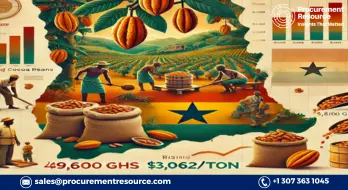Global Cocoa Prices Have Been Significantly Surging Amid Supply Shortage

The global cocoa prices are currently shooting up, primarily due to adverse weather conditions and supply chain disruptions. The phenomenon of El Niño, characterized by warmer surface temperatures in the Pacific Ocean, has led to hotter weather and altered rainfall patterns, particularly in West Africa. This region, which includes major cocoa-producing countries like Ivory Coast and Ghana, accounts for the majority of the world's cocoa supply.
The changing climate has posed a severe threat to cocoa crops, with heatwaves and intense rains causing a decline in harvests. This has placed a considerable strain on thousands of smallholder producers in the region, who have witnessed a reduction in their yields. Consequently, major cocoa processing plants in Ivory Coast and Ghana have either halted or reduced their operations due to the high cost of acquiring beans. This situation is expected to drive up chocolate prices globally, as these two countries produced 58% of the world's cocoa between 2022 and 2023.
The impact of poor cocoa harvests over the past three years, with a fourth anticipated, has already led chocolate-makers to increase prices for consumers. The shortage of cocoa beans has disrupted the usual trade mechanisms, where farmers sell beans to local dealers, who then sell them to processors or global traders. In times of scarcity, local dealers often pay a premium to farmers to secure beans, selling them on the spot market at higher prices rather than fulfilling pre-agreed contracts. This leaves processors short of beans and forces global traders to buy at elevated prices to meet their obligations to chocolate firms.
The International Cocoa Organisation (ICCO) forecasts a significant drop in global cocoa production by 10.9% to 4.45 million metric tons this season. With processors struggling to acquire beans, grindings—a measure of demand—will decrease by 4.8% to 4.78 million. As a result, the market is expected to face a deficit of 374,000 tons this season, a substantial increase from the 74,000-ton deficit last season. This supply-demand mismatch is likely to keep cocoa prices elevated and could lead to further increases in chocolate prices for consumers worldwide.
Read More About Cocoa Production Cost Reports - Request Free Sample Copy in PDF
According to the article by Procurement Resource, the global cocoa market is witnessing a price surge due to adverse weather and supply chain disruptions. El Niño has led to altered rainfall patterns in West Africa, affecting major cocoa producers like Ivory Coast and Ghana. The resulting decline in harvests has strained smallholder producers and halted processing plants, driving up chocolate prices. The International Cocoa Organisation forecasts a 10.9% drop in production, leading to a significant market deficit. This imbalance is expected to maintain high cocoa prices and potentially increase chocolate costs for consumers.



.webp)